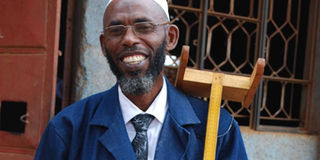Teacher makes local lab tools for schools

Mr Masudi Mwinyi wears the Mwinyi’s Physicist Laboratory Coat. The coat comes complete with fabricated apparatus needed for physics experiments at secondary schools. Photo BY MICHAEL J. SSALI
What you need to know:
Ambition. Masudi Mwinyi and a fellow teacher, Jackson Tibenda, started the Mobile Science Laboratory Facility innovation about 17 years ago with the aim of simplifying the teaching of science for cash-strapped secondary schools, writes Michael J. Ssali
Not so many people would think of a plastic straw used to drink soda as a simple device for substituting a magnifying glass.
However, according to Mr Masudi Mwinyi, a physics teacher for close to 30 years, it is a very useful object that a science teacher can use as a magnifying glass.
“Just fill it with water and place one of your fingers over one of its ends and it will hold the water for as long as you want to,” he told fellow science teachers at a recent seminar organised for physics teachers in Masaka Town. The seminar was attended by Masaka Municipality education officer Nalongo Ssekiwunga.
Affordable
“If you put it over a small object and you look at it through the straw, you will notice the object is magnified. And this is a science teaching equipment that any secondary school student can afford to construct since soda straws are so easy to get nearly everywhere in this country,” Mwinyi said.
The teachers were quickly taken through the practical exercise and at the end all of they agreed that the straw worked like a magnifying glass.
Mwinyi and a fellow teacher, Jackson Tibenda (Chemistry) started the Mobile Science Laboratory Facility (MOSLAFA) innovation about 17 years ago at Sseke Secondary School in Lwengo District with a view of simplify the teaching of science for most of the cash-strapped secondary schools mainly located in rural areas.
Under the MOSLAFA arrangement, students are enabled to acquire hands-on practical experience in conducting science experiments using minimum equipment, instead of the teacher conducting the experiment as the students merely watch.
A few sets of apparatus for conducting different experiments are laid out in a classroom and students work from one set to another in turns.
Many schools do not have enough apparatus for all their students to conduct experiments at a go and so it makes sense for the students to use the same apparatus in turns. The schools are also encouraged to pool resources to buy chemicals which they share. They may also buy expensive equipment like microscopes and rotate them form one school to another.

Mr Masudi Mwinyi works on some of the fabricated laboratory apparatus
Mwinyi is now taking the MOSLAFA arrangement to another level with his recent innovation, “Taking the science laboratory to the students’ home”. He wants each student to have a physics laboratory right in their homes.
Mwinyi has come up with the idea of Mwinyi’s Physicist’s Laboratory Coat (MPC), a coat that carries all the needed apparatus designed and fabricated by MOSLAFA to successfully conduct all secondary school physics experiments.
“As far as we are concerned, a laboratory need not be a building and high value timber tables or sophisticated equipment,” says Mwinyi. “With fabrication and improvisation, a mobile laboratory can be used to teach effectively.”
An Ordinary-Level student needs to complete the physics syllabus at a cost of just about Shs140,000, stocked at an average of Shs35,000 gradually every year as need arises. It is a coat that the student may wear and carry about, a personal toolbox for experiments.
“One hundred and forty thousand shillings is what some parents spend on just a single child on visiting days in some of the expensive secondary schools of this country, but it is what a student actually requires to effectively study physics in the four years of his Ordinary-Level course,” Mwinyi says. “It is even cheaper if the student chooses not to buy the lab coat.”
The apparatus on the MPC include Mwinyi’s Raised Rule (MRR) designed to circumvent the prohibitive cost of the traditional retort stand and also to overcome the stand’s limitations to lively learning experiences and for more accurate results. It has a swinging pendulum, the oscillating mass, pulley systems, among other apparatuses.
“The Uganda Registration Bureau Services cleared the MRR for patent protection under the intellectual property laws after conducting patent search and was able to prove that the MRR is an invention!” he says.
He has received government’s special recognition because of his consistent effort to promote quality science teaching in secondary schools.
Recognised
President Museveni awarded him a medal for teacher of excellence -- the only recipient in the secondary category, at the 50th Independence anniversary celebrations held in Rukungiri District last year.
Ms Ssekiwunga has described the MOSLAFA innovations as brilliant and she believes they demystify the teaching and learning of science. “If the teachers are resourceful and are committed to their job, it is possible for the students in rural schools to do well in science subjects,” she says.
Mr Jerome Tamale, now a medical student at Kampala International School, is grateful to MOSLAFA for the assistance he got when he was in his A-Level.
“Back then, they also had second-hand science books which I borrowed and managed to pass my science subjects,” he says.




